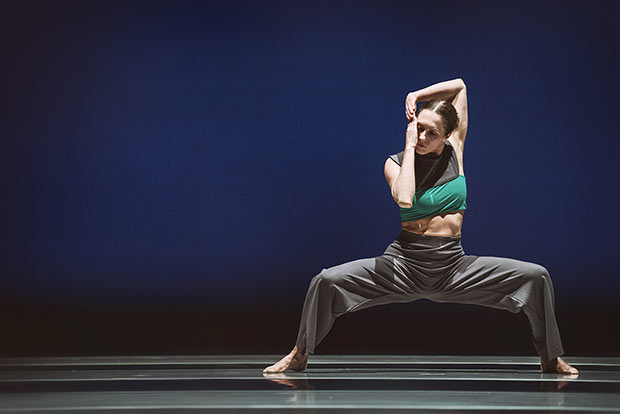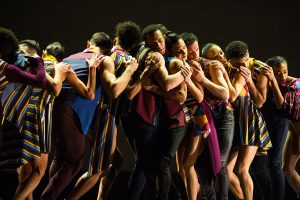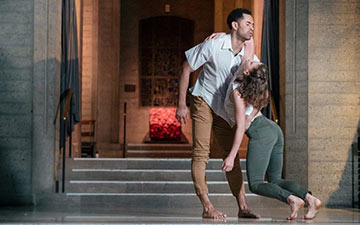
© Andrew Weeks. (Click image for larger version)
ODC/Dance
Summer Sampler – Program 1: Head in the Sand, Something About a Nightingale, Giant
★★★✰✰
San Francisco, ODC Theater
20 July 2018
www.odc.dance
Every once in a while, as I head to a contemporary dance program, I find myself hoping a ‘lighter’ evening might be in store. Much of the contemporary choreography I’ve seen lately has been laden with angsty themes and an abundance of gravity. And I get it. There’s certainly no shortage of heaviness to unpack these days. Still, that craving for a hopeful lens and joyful energy pops up now and again, and it did on Friday night. Maybe it was the calm, summer weather in San Francisco. Maybe it was my mood that day. Maybe it’s because I refuse to believe that contemporary dance has to be heavy in order to be relevant. In any case, this is where my mind was as I made my way to ODC Theater for ODC/Dance’s Summer Sampler.
An annual event, Summer Sampler showcases choreographic work by dancemakers within the ODC family. In the past it has been a single bill, but this year has seen a broadening of the long-running company’s programming. In the spring, their home season moved from one concert to two different shows at two venues. 2018’s Summer Sampler has similarly followed suit and moved to two unique programs. The first one opened this past weekend – Associate Choreographer Kimi Okada’s Head in the Sand (2017), Artistic Director Brenda Way’s Something About a Nightingale (2005) and Choreographer in Residence Kate Weare’s Giant (2016), remounted by Co-Artistic Director KT Nelson. A solid program overall, there were moments that satiated my craving for lightness and moments that challenged it.
Described in the program as “coping with misfortune”, I thought for sure that Okada’s Sand was going to be the weightiest piece on the program. It wasn’t; it was actually both broad and nuanced. Dealing with bad news carries with it many emotions and responses, and is a process sometimes navigated alone and sometimes with others. Sand spoke to this range, making it both a compelling, relatable work, and a great start to the evening. A quartet danced by Natasha Adorlee, Jeremy Bannon-Neches, Tegan Schwab and Daniel Santos, Sand’s more serious moments unfolded in its first half. Feet trudged along the surface of the stage; arms shook in frenetic spasm; palms shielded the eyes from outside realities. Everything felt desperate, fearful and dire. Exhausted, the four collapsed into an emotionally drained heap. And then a real, genuine tenderness washed over the space. As they unfurled from this pile, the dancers cradled each other’s heads and rested their hands on each other’s shoulders. They mirrored each other’s movements in togetherness and understanding. Carrying each other on their backs, they offered unconditional support. Varying perspectives, a breadth of tone. This is why Sand was good.
Choreographically, Way’s Nightingale was fun, light and whimsical. And certainly reflected its intention “to suggest (and embody) the unpredictable magic of inspiration.” An ensemble work for six, Nightingale was an unfettered physical essay, almost like a stream of consciousness. New choreographic ideas emerged at every turn. You couldn’t anticipate where Nightingale was headed, and I found that very exciting. Technical choreography would suddenly include unexpected, quirky elements like the peace sign, a hitchhiker’s thumb or a crab walk. Fluttering feet, hops to the side and parallel bourées felt distinctly youthful, adding a measure of childlike wonder to the mix. And there was great attention to isolated and individual movements: shoulders rolling, fingers shaking, hips popping, the solarplexus reaching towards the heavens. As much as I loved all these movement phrases, there was one thing desperately missing from Nightingale: a stage attitude to match the eclectic choreography. Only two of the dancers (Brandon Freeman and Lani Yamanaka) were able to capture Nightingale’s whimsy in their bodies and through their facial expressions. Everyone else got the former but not the latter. The remaining four faces were as somber as could be, bordering on grim. It didn’t fit.

© Andrew Weeks. (Click image for larger version)
By far, the weightiest piece on the bill was Weare’s Giant, a work centered on themes of power, resilience and fortitude. Danced by nine ODC company members, Giant reads like a dance suite – a series of consecutive and distinct movement episodes. With each one came new metaphors for strength. Stick-straight arms sliced through the space with unrelenting tenacity. Power stances abounded: deep lunges, wide second positions and piercing arabesque lines. Dancers propelled forward no matter who might be in their path, sometimes stepping over bodies and occasionally on them. And a Haka-inspired percussive sequence for Giant’s women radiated power and might. Giant’s imagery was strong and clear, but its overall cohesiveness was another story.
Giant was the only Summer Sampler dance that I had seen before. And like the first time I saw it, it wasn’t my favorite. Not because of the cast – the dancing was impressive. Not because of the choreography – I quite enjoyed the movement. Not even because of the lack of joy, though joy and strength are by no means contraindicative, and I think it could have been a welcome addition to an otherwise weighty dance. It was because of the compositional format, which didn’t buoy the piece. With multiple consecutive scenes, inevitably there will be some break in the action as one section ends and the next begins. Giant had so many of these transitions: some lengthy, some brief; tons of entrances and exits; abundant light and music cues. Maintaining continuity through these breaks is a tall order and here, it didn’t pan out. During these countless stops and starts, the energy, flow and atmosphere nosedived. Giant was constantly being interrupted. And so it felt like short, individual dances rather than one complete work.

















You must be logged in to post a comment.